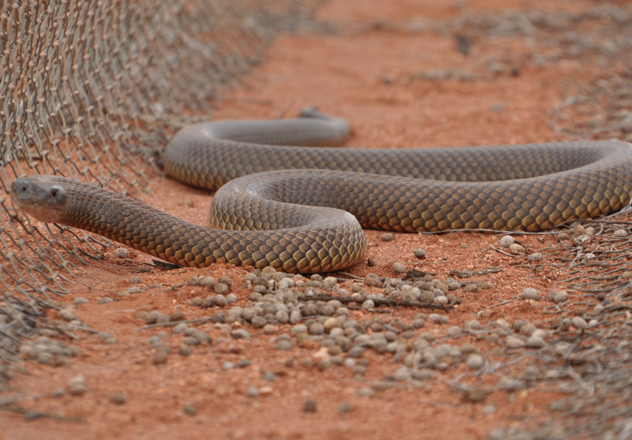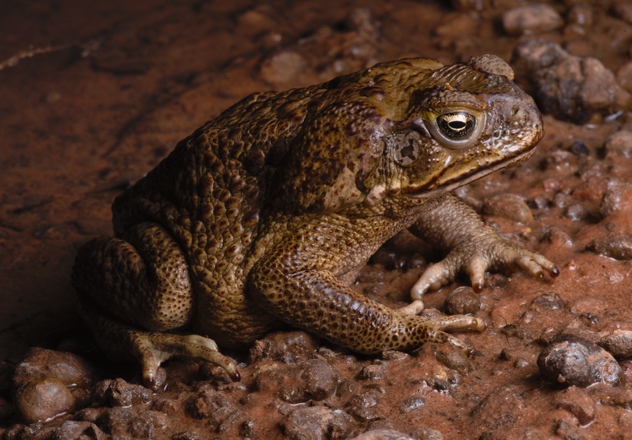Also known as the King Brown Snake, the Mulga Snake (Pseudechis australis) is one of the 140 known land species of snake in Australia. Despite its common name, it is only distantly related to true brown snakes (genus Pseudonaja) and instead, more closely related to the Red-Bellied Black Snake. It is Australia’s largest terrestrial venomous snake, found across the vast majority of the continent.

 Matt Lynn/AWC
Matt Lynn/AWC
AWC’s sanctuaries help to protect many of Australia’s magnificent native species including the Mulga Snake. Ongoing vegetation management through fire regimes, weed control, and revegetation is helping to promote the continuation of natural conditions and thus the persistence of species such as the Mulga Snake.
Excitingly, in 2021, rare footage of two male snakes wrestling for dominance at AWC’s Scotia Wildlife Sanctuary in southwestern NSW was captured, an event that has previously been witnessed at the Mornington-Marion Downs Wildlife Sanctuary as well.
 Ian Bool/AWC
Ian Bool/AWC
While juvenile snakes can fall victim to large birds of prey, there are few predators for adult Mulga Snakes. The only real threat to Mulga Snakes is the expansion of the cane toad population as frogs and other amphibians make up a normal part of the carnivorous snakes’ diet. Indeed, the parotoid glands on the shoulders of cane toads release a toxin that can sicken or kill a snake, depending on the amount of the poison ingested. A local decline has been seen in Queensland as a result, however populations remain strong across the rest of the continent.
Despite this, because of their large range and their resultant adaptability to many environmental conditions, they are considered a species of least concern.

Description
The Mulga Snake is the largest venomous Australian snake, averaging 2.5m in length, with the largest recorded at 3.3m. Males tend to be approximately 20% larger than females, both in length and weight, while juveniles appear finer and grow more robust with age.
These snakes have two-toned scales of pale brown, olive, or reddish brown, and a darker hind edge, while their belly is cream- or salmon-coloured. Interestingly, when the snake is moving, these scale colours merge into a greenish colour providing a fabulous camouflage for unsuspecting prey.
There is also spatial variability in colour, with individuals from the northern arid regions having much lighter while their southern counterparts display significantly more pigment in their darker scales.
Ecology
Their activity depends predominantly on their geographic location; more northern populations tend to have crepuscular activity, being most active at dusk, while southern populations are more active throughout the day as temperatures are cooler. During their less-active times, the snakes will curl up in soil crevices, old animal burrows, or under rocks and logs to avoid high temperatures.
Their diet consists predominantly of small mammals, reptiles, birds, frogs, and even other snakes. They have been known to consume medium-sized goannas as well. They are an opportunistic predator, taking advantage of the season and their environment, and adapting their diet accordingly. For example, they may consume more frogs if they live in a wetter region.
The breeding season again depends on their geographic location with northern populations breeding during the wet season when food is abundant, compared with southern populations who breed largely during spring. Male snakes wrestle for dominance with their forebody risen in an attempt to push their opponent’s head down, while their hind bodies are entwined in a coil. This behaviour can continue for multiple hours with the winner receiving mating rights to local females.
This wrestling is often confused with mating behaviour however mating occurs with slower rubbing movements.
Mulga Snakes are oviparous, with females laying 10 eggs on average, whereby the majority of embryonic development occurs after the eggs are laid. This is a common trait amongst fish, amphibians, monotremes, and reptiles. The eggs hatch after 70 to 100 days and baby snakes measure just 22cm and weigh 9.4cm.
They have been reported to live up to 25 years in captivity, while lifespans in the wild are expected to be slightly shorter.
Range and Abundance
The Mulga Snake has the widest distribution of any snake species in Australia, found in all states and territories except Victoria and Tasmania. Despite their name, they are not confined to mulga habitats and can survive in woodlands, hummock grasslands, chenopod scrublands, and gibber and sandy deserts. In arid and semi-arid regions, they are typically found near water courses.
They are also a highly adaptable species, able to survive in human-modified environments such as wheat fields, rubbish dumps, and vacated buildings. They have also modified their behaviour to suit the introduced buffel grass, enjoying regions covered in this grass due to the dense, year-round cover it provides.
Donate to help protect species such as the Mulga Snake
Donate Now“Scotia Wildlife Sanctuary … a vitally important project for Australia and for the planet.” – Sir David Attenborough Scotia Wildlife...
Mornington – Marion Downs is a model for conservation in northern Australia, protecting 580,772 hectares of the iconic Kimberley region.
Mt Gibson Wildlife Sanctuary protects a large area of diverse habitat in the south of Western Australia. As the site...
W. Lawler/AWCBurrowing Bettongs (or often referred to as Boodies in western and southern Australia), are a small, thick-set, kangaroo-like animal.
AWC protects populations of the Southern Hairy-nosed Wombat at Yookamurra and Dakalanta Wildlife Sanctuaries.
Koalas inhabit eucalypt forests and woodlands in eastern Australia from north Queensland through to south-east South Australia.